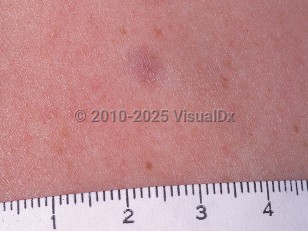Eccrine spiradenoma
Alerts and Notices
Important News & Links
Synopsis

Eccrine spiradenomas (or spiradenomas) are rare, well-differentiated, dermal tumors of the eccrine sweat glands. The lesions typically appear at age 15-35 years, with equal predominance in men and women, although they have been reported in infants. The characteristic clinical presentation is that of a painful, slow-growing, blue, gray, or purple nodule on the head, neck, or trunk.
Eccrine spiradenomas are usually small solitary lesions, but other patterns such as multiple lesions, zosteriform, blaschkoid / linear, nevoid, familial, congenital, or giant eccrine spiradenoma have uncommonly been reported.
Brooke-Spiegler syndrome is a condition that may manifest multiple eccrine spiradenomas, along with cylindromas and trichoepitheliomas. The syndrome is due to a mutation in the CYLD gene on chromosome 9, inherited in an autosomal dominant pattern.
Eccrine spiradenomas have a low recurrence rate after surgical excision. Malignant degeneration may occur, but it is very rare and usually occurs in patients older than 50 years. Multiple eccrine spiradenomas are more likely to undergo malignant transformation than solitary lesions. Malignant eccrine spiradenomas tend to be larger and ulcerated and more commonly involve the trunk or extremities. Metastases were present in about one-third of cases cited in a recent literature review; these were primarily to the lymph nodes, but also occurred to the lungs, brain, and liver less frequently. The molecular pathways involved in malignant degeneration have not been clarified. Increased p53 expression has been identified; however, the significance of this expression is unknown.
Eccrine spiradenomas are usually small solitary lesions, but other patterns such as multiple lesions, zosteriform, blaschkoid / linear, nevoid, familial, congenital, or giant eccrine spiradenoma have uncommonly been reported.
Brooke-Spiegler syndrome is a condition that may manifest multiple eccrine spiradenomas, along with cylindromas and trichoepitheliomas. The syndrome is due to a mutation in the CYLD gene on chromosome 9, inherited in an autosomal dominant pattern.
Eccrine spiradenomas have a low recurrence rate after surgical excision. Malignant degeneration may occur, but it is very rare and usually occurs in patients older than 50 years. Multiple eccrine spiradenomas are more likely to undergo malignant transformation than solitary lesions. Malignant eccrine spiradenomas tend to be larger and ulcerated and more commonly involve the trunk or extremities. Metastases were present in about one-third of cases cited in a recent literature review; these were primarily to the lymph nodes, but also occurred to the lungs, brain, and liver less frequently. The molecular pathways involved in malignant degeneration have not been clarified. Increased p53 expression has been identified; however, the significance of this expression is unknown.
Codes
ICD10CM:
D23.9 – Other benign neoplasm of skin, unspecified
SNOMEDCT:
403938001 – Eccrine spiradenoma
D23.9 – Other benign neoplasm of skin, unspecified
SNOMEDCT:
403938001 – Eccrine spiradenoma
Look For
Subscription Required
Diagnostic Pearls
Subscription Required
Differential Diagnosis & Pitfalls

To perform a comparison, select diagnoses from the classic differential
Subscription Required
Best Tests
Subscription Required
Management Pearls
Subscription Required
Therapy
Subscription Required
References
Subscription Required
Last Reviewed:11/18/2020
Last Updated:11/22/2020
Last Updated:11/22/2020
Eccrine spiradenoma

